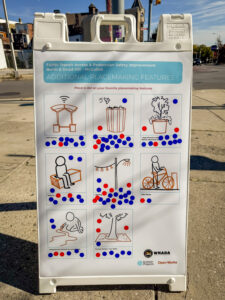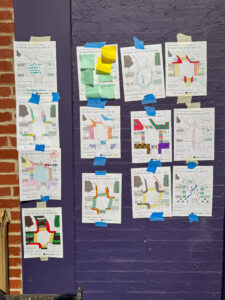In West Baltimore, our partners West North Avenue Development Authority (WNADA), Graham Projects, and Open Works hosted a community engagement pop-up to redesign West North Avenue. This event showcased emerging best practices in public engagement when executing infrastructure projects. These efforts demonstrate ways public agencies can prioritize community voices in their planning and design decisions. 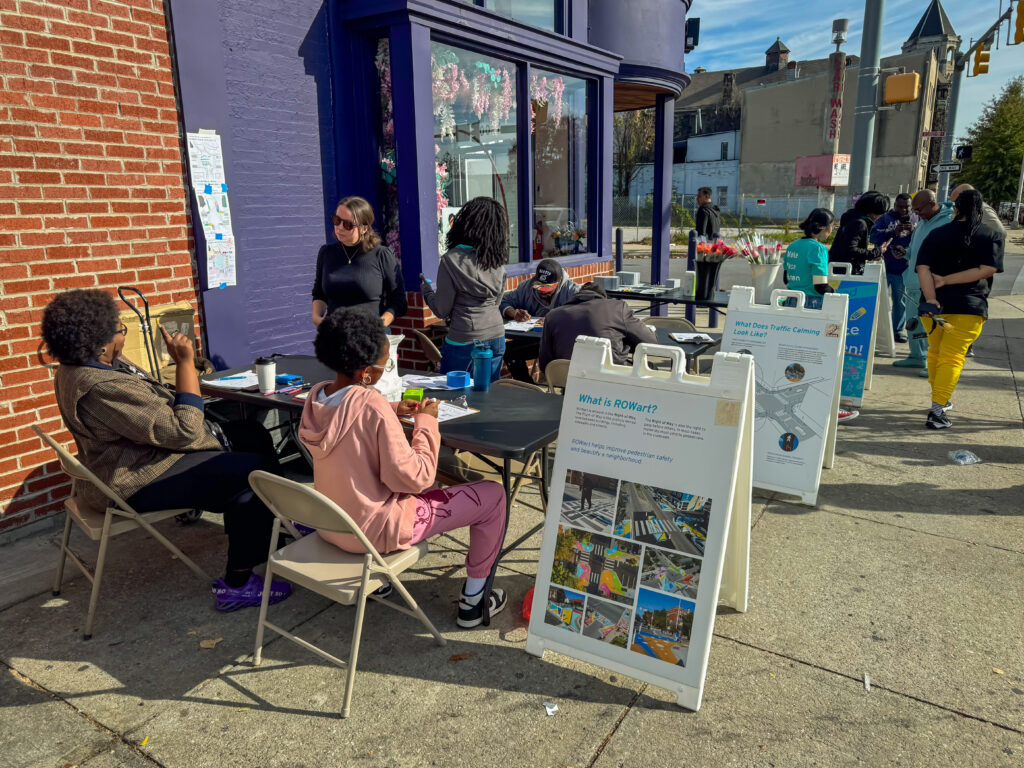
West Baltimore has faced a long history of redlining and disinvestment, leading to high vacancy rates and a neighborhood in need of equity-centered economic development.Enter T4America member West North Avenue Development Authority (WNADA), a Maryland General Assembly-established group, formed to enhance mobility, public spaces, and economic opportunity along West North Avenue. With 30 mph speed limits and wide lanes, this main corridor is dangerous by design. As new commercial developments emerge on the corridor, WNADA is working hard to introduce traffic calming and placemaking street elements to create a pedestrian-friendly neighborhood.
WNADA’s newest project involves a redesign of two intersections along West North Avenue: McCulloh Street and Druid Hill Avenue. After a stakeholder walk of the area with community leaders, residents, and business owners, WNADA hosted a community pop-up event on November 2, alongside Graham Projects, a public art and placemaking group, and Open Works, a nonprofit makerspace.
Redefining community events
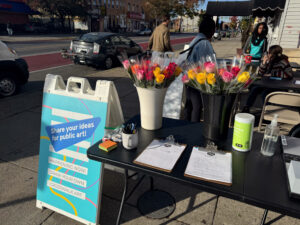 Unlike traditional public meetings, the Fleurs d’Ave Pop-up event encouraged local residents to design their own vision for West North Avenue. “It’s really important that you acknowledge everyone who is on the street and using these public spaces,” Graham Projects Founder Graham Coreil-Allen noted. “The diversity you see [at these events] is much greater than in traditional planning meetings.” The pop-up eliminated typical barriers, like traveling at inconvenient times or decoding planning jargon. Residents were met where they live and were engaged early so their ideas could be reflected in the final plan. The roughly 30 attendees included commuters waiting for the bus and people walking by Fleurs d’Ave. Attendees filled out a survey about their perceptions of the two intersections, drew their own redesigns for the area, and provided comments on WNADA’s plan. This kind of engagement is a testament to how spaces can be designed by and for the community.
Unlike traditional public meetings, the Fleurs d’Ave Pop-up event encouraged local residents to design their own vision for West North Avenue. “It’s really important that you acknowledge everyone who is on the street and using these public spaces,” Graham Projects Founder Graham Coreil-Allen noted. “The diversity you see [at these events] is much greater than in traditional planning meetings.” The pop-up eliminated typical barriers, like traveling at inconvenient times or decoding planning jargon. Residents were met where they live and were engaged early so their ideas could be reflected in the final plan. The roughly 30 attendees included commuters waiting for the bus and people walking by Fleurs d’Ave. Attendees filled out a survey about their perceptions of the two intersections, drew their own redesigns for the area, and provided comments on WNADA’s plan. This kind of engagement is a testament to how spaces can be designed by and for the community.
Art as an engagement tool
Over coffee from local roaster Matriarch Coffee and refreshments from Plantation Park Heights Urban Farm, both Black-owned businesses, the community at large expressed clear priorities for their neighborhood. In addition to having a plan for safer bus stops and better lighting, residents suggested beautifying the area by planting native plants, adding more waste bins, and creating more seating, especially bus stop benches. Participants also drew their own crosswalk pavement art using themes like safe streets, flowers, boxing, African symbols, music notes, and other elements representing West Baltimore’s vibrant culture. The excitement residents had around creating a more colorful and vibrant neighborhood reinforces the role art and culture play in creating affordable, safe, supportive, and thriving communities., “Our vision is that the people that have been most harmed by our infrastructure system are instead centered and leading efforts to repair, heal, and redesign their communities,” said Marian Liou, Smart Growth America’s Director of Arts and Culture “Artists and culture bearers in these communities are essential leaders, collaborators, and instigators in this work, which this project represents.”
Next steps
Now, staff at WNADA have been canvassing the neighborhood as a part of the Baltimore City DOT Community-led Placemaking program. Unsurprisingly, after multiple community events about the plans, over 90% of residents and business owners support these changes to North Avenue. While they work on approval from Baltimore DOT to implement new bus platforms, lighting, and other placemaking elements, Baltimore artists Zoe Roane-Hopkins and JaVon L. Townsend are developing pavement art designs, using inspiration from what community members drew. In an area where around half the residents don’t drive, WNADA is leading the charge on designing a multimodal corridor to improve transit accessibility. Through the collaboration with Graham Projects and Open Works, West Baltimore residents have a hand in the project every step of the way and will soon see their artwork and vision across North Avenue. 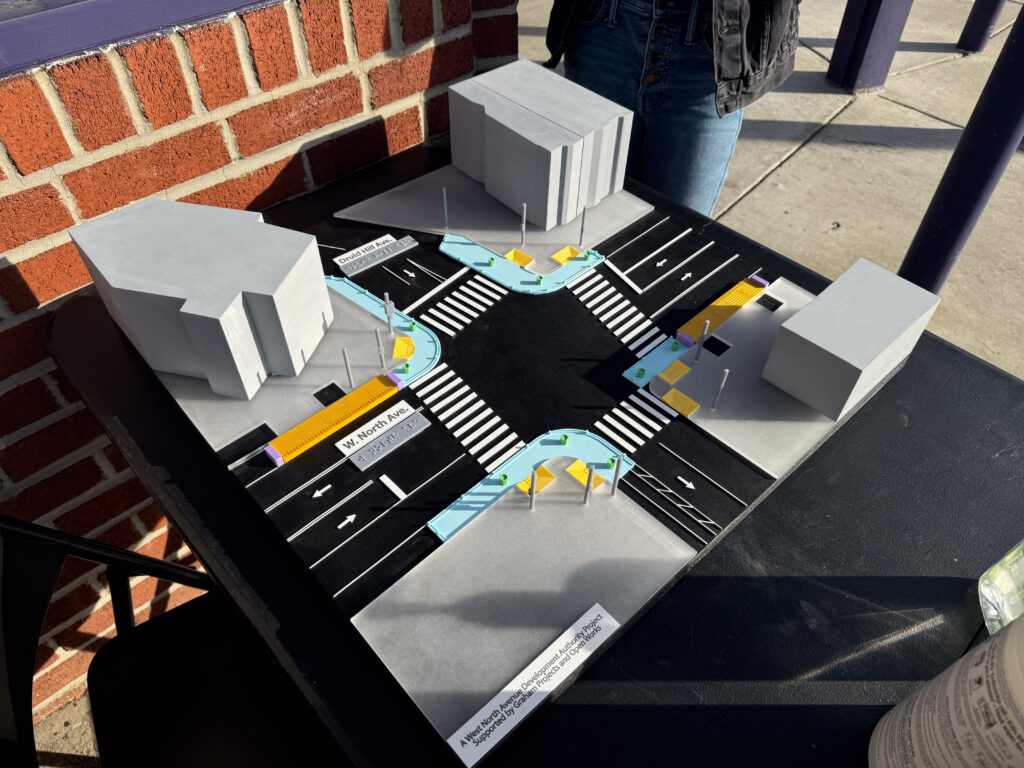
The post Art meets action: Revitalizing West Baltimore appeared first on Transportation For America.







